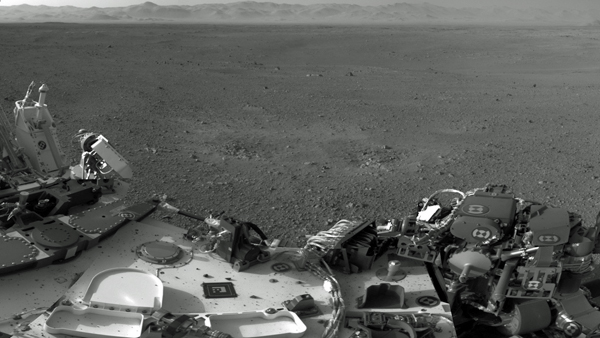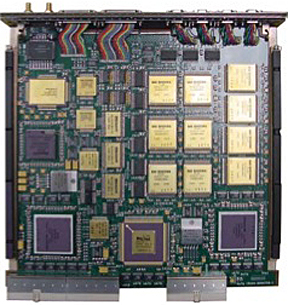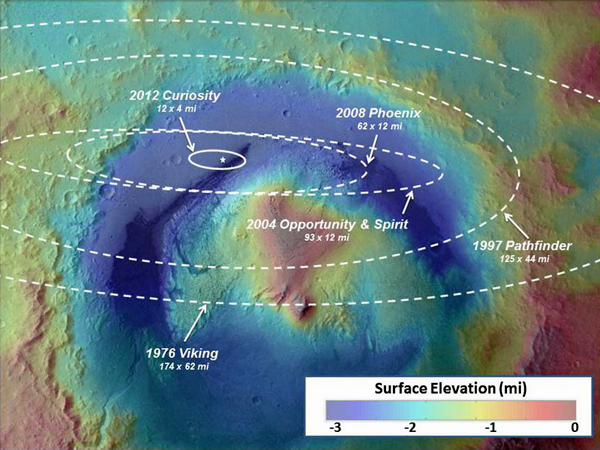Slow but rugged, Curiosity computer up to challenge at Mars
By WILLIAM HARWOOD
CBS News
The electronic brain controlling NASA's Curiosity Mars rover has far less horsepower than the microchips typically found in a modern smart phone.
But the RAD750 PowerPC microprocessor built into the rover's redundant flight computers has one enormous advantage: It was engineered to be virtually impervious to high-energy cosmic rays that would quickly cripple an iPhone or laptop computer.
The radiation-hardened single-card computers, built by BAE Systems in Manassas, Va., are designed to withstand charged ions and protons in interplanetary space or on the surface of Mars that can physically damage integrated circuits or trigger so-called "bit flips" in which the logic of the computer can be temporarily, or even permanently, disrupted.
The RAD750s also meet lifetime dosage standards that are up to a million times more extreme than those considered fatal for a human being. As a result, over a 15-year period, the RAD750 chips aboard Curiosity would not be expected to suffer more than one external event requiring intervention from Earth.
"The RAD750 card is designed to accommodate all those single event effects and survive them," Vic Scuderi, BAE business manager for satellite electronics, said in an interview. "The ultimate goal is one upset is allowed in 15 years. An upset means an intervention from Earth -- one 'blue screen of death' in 15 years. We typically have contracts that (specify) that."
Engineers at NASA's Jet Propulsion Laboratory in Pasadena, Calif., plan to spend the next four days loading a major software update into Curiosity's redundant flight computers, flushing out the no-longer-needed entry, descent and landing application and replacing it with software optimized for surface operations.
The R10 update includes programming to operate the rover's sample acquisition instruments, its robot arm and its six-wheel drive system.
The new flight software was uplinked to Curiosity while the spacecraft was on the way to Mars. Starting late Friday, engineers will begin installing the R10 update in stepwise fashion, first on one computer and then on the other, testing as they go along to make sure all is well.
"Right now, we have the capability of just our basic surface software to check out the health of the instruments, but we don't really have the capability to go and make the full use of all this great hardware we shipped to Mars," said Ben Cichy, a senior software engineer at JPL.
"So the R10 software gives us the capability to use the robotic arm fully, to use the drill, to use the dust removal tool, to use the whole sampling chain, all this exciting stuff."
Curiosity is a "martian megarover," Cichy said. "Curiosity was born to drive, and so the R10 software includes the capability for Curiosity to really get out and stretch her wheels on the surface of Mars. So the R10 software gives us the autonomous driving capability, the ability for the rover to drive using on-board images to detect hazards that are around the rover and to drive safely across the surface of Mars."
The rover is equipped with two computers, but only one is active at a time. Both are built around a radiation-hardened BAE RAD750 microchip operating at up to 200 megahertz. Each computer is equipped with 2 gigabytes of flash memory, 256 megabytes of random access memory and 256 kilobytes of erasable programmable read-only memory.
The BAE-provided RAD6000-based computers aboard the Mars Odyssey orbiter and the Spirit and Opportunity rovers are 10 times slower and feature eight times less memory than the RAD750 cards aboard Curiosity. The more powerful microchip also is used by NASA's Mars Reconnaissance Orbiter and will be integrated into the James Webb Space Telescope.
While their technical specifications appear to lag well behind the chips used in readily available consumer electronics, those devices don't require anywhere near the rigorous design work, testing and qualification that goes into a space-rated processor.
"First, you have to develop the radiation hardening techniques and actually implement them in the design," said Scott Doyle, a BAE systems engineer for satellite electronics. "The next step is you have to qualify each of those individual components and that qualification is normally a year, a year-and-a-half, just to do that.
"Then they get integrated on the board, and that board has to go through qualification activity to prove out the board. Then once that board gets integrated into the satellite at the system level, there's several years worth of qualification testing that goes in at the satellite level. You add all that up, you're talking five to eight years of qualification work."
The resulting computers can cost anywhere from $200,000 to a half-million dollars. While all that might seem like overkill to an outsider, space-based computers simply have to work.
"There's no repair man in space," Doyle said.
But given the unavoidable limitations in processing speed and memory, Curiosity's programmers face a daunting task when it comes to writing software.
"What's hard about this, my phone has a processor that's 10 times as fast as the processor that's on Curiosity and it has 16 times as much storage as Curiosity has and my phone doesn't have to land anything on Mars," Cichy said. "All my phone has to do is follow (a friend's) Twitter feed.
"So the challenging part about this is that my phone wouldn't survive the journey to Mars, so we have to build computers that are robust enough to survive the harsh (environment of) interplanetary space. And when we do that, there are certain limitations we have and some of those limitations include the size of the flight software image that we have, and that forces us every now and then to update the flight software to add new capabilities."
'
If all goes well, the R10 software update will be complete early next week.
Looking down the road to future spacecraft, BAE Systems is developing a quad-core processor for space-based applications that will run at gigahertz speeds and be capable of an enormous number of calculations, or instructions, per second. The new computers will be especially useful for image processing.
"It's really going to be a matter of MIPS, that's million instructions per second," Scuderi said. "For the RAD750 today, the MIPS can get as high as 500. We'll go into the gigabit, or gigamip, or gip, I guess will be the next (unit). Billions and gazillions how about that?" he joked.
CBS News
The electronic brain controlling NASA's Curiosity Mars rover has far less horsepower than the microchips typically found in a modern smart phone.
But the RAD750 PowerPC microprocessor built into the rover's redundant flight computers has one enormous advantage: It was engineered to be virtually impervious to high-energy cosmic rays that would quickly cripple an iPhone or laptop computer.
 |
| Part of a black-and-white panorama showing the northern rim of Gale Crater in the distance with the Curiosity rover's dirt-speckled upper deck in the foreground. (Credit: NASA) |
The radiation-hardened single-card computers, built by BAE Systems in Manassas, Va., are designed to withstand charged ions and protons in interplanetary space or on the surface of Mars that can physically damage integrated circuits or trigger so-called "bit flips" in which the logic of the computer can be temporarily, or even permanently, disrupted.
The RAD750s also meet lifetime dosage standards that are up to a million times more extreme than those considered fatal for a human being. As a result, over a 15-year period, the RAD750 chips aboard Curiosity would not be expected to suffer more than one external event requiring intervention from Earth.
"The RAD750 card is designed to accommodate all those single event effects and survive them," Vic Scuderi, BAE business manager for satellite electronics, said in an interview. "The ultimate goal is one upset is allowed in 15 years. An upset means an intervention from Earth -- one 'blue screen of death' in 15 years. We typically have contracts that (specify) that."
Engineers at NASA's Jet Propulsion Laboratory in Pasadena, Calif., plan to spend the next four days loading a major software update into Curiosity's redundant flight computers, flushing out the no-longer-needed entry, descent and landing application and replacing it with software optimized for surface operations.
 |
| The single-board computer aboard NASA's Curiosity rover is built around a PowerPC RAD750 microprocessor provided by BAE Systems. While slower than the latest generation of chips in readily available consumer electronics, the computer is virtually impervious to massive amounts of radiation and other environmental extremes. (Credit: BAE Systems) |
The new flight software was uplinked to Curiosity while the spacecraft was on the way to Mars. Starting late Friday, engineers will begin installing the R10 update in stepwise fashion, first on one computer and then on the other, testing as they go along to make sure all is well.
"Right now, we have the capability of just our basic surface software to check out the health of the instruments, but we don't really have the capability to go and make the full use of all this great hardware we shipped to Mars," said Ben Cichy, a senior software engineer at JPL.
"So the R10 software gives us the capability to use the robotic arm fully, to use the drill, to use the dust removal tool, to use the whole sampling chain, all this exciting stuff."
Curiosity is a "martian megarover," Cichy said. "Curiosity was born to drive, and so the R10 software includes the capability for Curiosity to really get out and stretch her wheels on the surface of Mars. So the R10 software gives us the autonomous driving capability, the ability for the rover to drive using on-board images to detect hazards that are around the rover and to drive safely across the surface of Mars."
The rover is equipped with two computers, but only one is active at a time. Both are built around a radiation-hardened BAE RAD750 microchip operating at up to 200 megahertz. Each computer is equipped with 2 gigabytes of flash memory, 256 megabytes of random access memory and 256 kilobytes of erasable programmable read-only memory.
The BAE-provided RAD6000-based computers aboard the Mars Odyssey orbiter and the Spirit and Opportunity rovers are 10 times slower and feature eight times less memory than the RAD750 cards aboard Curiosity. The more powerful microchip also is used by NASA's Mars Reconnaissance Orbiter and will be integrated into the James Webb Space Telescope.
While their technical specifications appear to lag well behind the chips used in readily available consumer electronics, those devices don't require anywhere near the rigorous design work, testing and qualification that goes into a space-rated processor.
 |
| Curiosity's flight computer controlled a guided entry through the martian atmosphere, allowing a pinpoint landing in Gale Crater. Curiosity's predicted landing ellipse is shown here compared to those of previous Mars landers. (Credit: NASA) |
"First, you have to develop the radiation hardening techniques and actually implement them in the design," said Scott Doyle, a BAE systems engineer for satellite electronics. "The next step is you have to qualify each of those individual components and that qualification is normally a year, a year-and-a-half, just to do that.
"Then they get integrated on the board, and that board has to go through qualification activity to prove out the board. Then once that board gets integrated into the satellite at the system level, there's several years worth of qualification testing that goes in at the satellite level. You add all that up, you're talking five to eight years of qualification work."
The resulting computers can cost anywhere from $200,000 to a half-million dollars. While all that might seem like overkill to an outsider, space-based computers simply have to work.
"There's no repair man in space," Doyle said.
But given the unavoidable limitations in processing speed and memory, Curiosity's programmers face a daunting task when it comes to writing software.
"What's hard about this, my phone has a processor that's 10 times as fast as the processor that's on Curiosity and it has 16 times as much storage as Curiosity has and my phone doesn't have to land anything on Mars," Cichy said. "All my phone has to do is follow (a friend's) Twitter feed.
"So the challenging part about this is that my phone wouldn't survive the journey to Mars, so we have to build computers that are robust enough to survive the harsh (environment of) interplanetary space. And when we do that, there are certain limitations we have and some of those limitations include the size of the flight software image that we have, and that forces us every now and then to update the flight software to add new capabilities."
'
If all goes well, the R10 software update will be complete early next week.
Looking down the road to future spacecraft, BAE Systems is developing a quad-core processor for space-based applications that will run at gigahertz speeds and be capable of an enormous number of calculations, or instructions, per second. The new computers will be especially useful for image processing.
"It's really going to be a matter of MIPS, that's million instructions per second," Scuderi said. "For the RAD750 today, the MIPS can get as high as 500. We'll go into the gigabit, or gigamip, or gip, I guess will be the next (unit). Billions and gazillions how about that?" he joked.